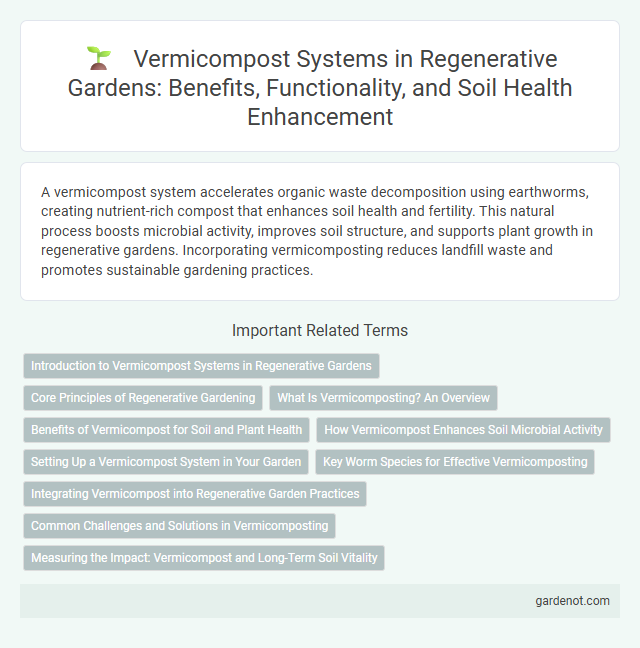A vermicompost system accelerates organic waste decomposition using earthworms, creating nutrient-rich compost that enhances soil health and fertility. This natural process boosts microbial activity, improves soil structure, and supports plant growth in regenerative gardens. Incorporating vermicomposting reduces landfill waste and promotes sustainable gardening practices.
Introduction to Vermicompost Systems in Regenerative Gardens
Vermicompost systems in regenerative gardens use earthworms to transform organic waste into nutrient-rich compost, enhancing soil fertility and structure naturally. This process accelerates decomposition while improving microbial activity and water retention, crucial for sustainable plant growth. Incorporating vermicomposting reduces the need for chemical fertilizers and supports a closed-loop nutrient cycle.
Core Principles of Regenerative Gardening
Vermicompost systems embody the core principles of regenerative gardening by enhancing soil fertility through natural microbial activity and nutrient recycling. This method promotes biodiversity by creating a habitat for earthworms and beneficial microorganisms that break down organic waste into nutrient-rich compost. Integrating vermicompost enriches soil structure, increases water retention, and supports sustainable plant growth without chemical inputs.
What Is Vermicomposting? An Overview
Vermicomposting is a sustainable process that uses specific earthworm species, such as Eisenia fetida, to decompose organic waste into nutrient-rich compost. This method accelerates the breakdown of kitchen scraps, garden trimmings, and paper products, producing vermicast rich in beneficial microbes and essential nutrients like nitrogen, phosphorus, and potassium. Implementing a vermicompost system enhances soil structure, boosts plant growth, and supports regenerative gardening practices by recycling organic matter efficiently.
Benefits of Vermicompost for Soil and Plant Health
Vermicompost enhances soil structure by increasing aeration and moisture retention, promoting healthy root development. Rich in essential nutrients and beneficial microorganisms, vermicompost boosts plant growth and disease resistance naturally. This sustainable organic fertilizer improves soil fertility while reducing the need for chemical inputs in regenerative gardening systems.
How Vermicompost Enhances Soil Microbial Activity
Vermicompost significantly boosts soil microbial activity by introducing beneficial microorganisms that accelerate organic matter decomposition and nutrient cycling. The diverse microbial population in vermicompost improves soil structure, increases nutrient availability, and promotes plant growth. Enhanced microbial activity also helps suppress soil-borne pathogens, contributing to healthier and more resilient garden ecosystems.
Setting Up a Vermicompost System in Your Garden
To set up a vermicompost system in your garden, start by selecting a suitable container with proper ventilation and drainage to maintain an aerobic environment for the worms. Use red wigglers (Eisenia fetida), known for their efficiency in breaking down organic matter, and provide a balanced feed of kitchen scraps, shredded paper, and garden waste to promote healthy worm activity. Position the system in a shaded, cool area to regulate temperature and moisture, optimizing the decomposition process and resulting in nutrient-rich vermicompost for your plants.
Key Worm Species for Effective Vermicomposting
Eisenia fetida, commonly known as red wigglers, are the most effective worm species for vermicomposting due to their high reproduction rate and ability to consume large amounts of organic waste. Lumbricus rubellus also contributes significantly by breaking down organic material rapidly, enhancing nutrient cycling in regenerative gardens. Integrating a mix of these worm species optimizes decomposition rates and improves the overall quality of vermicompost for soil enrichment.
Integrating Vermicompost into Regenerative Garden Practices
Integrating a vermicompost system into regenerative garden practices enriches soil health by enhancing microbial activity and nutrient cycling. Worm castings provide a rich source of organic matter, improving soil structure and water retention, essential for resilient plant growth. Implementing vermiculture supports waste reduction, transforming organic scraps into valuable fertilizer that sustains a closed-loop ecosystem within the garden.
Common Challenges and Solutions in Vermicomposting
Vermicompost systems often face challenges such as excess moisture, improper temperature, and pest infestations, which can disrupt worm activity and compost quality. Maintaining optimal moisture levels between 70-90%, ensuring temperatures remain within 55-77degF (13-25degC), and using breathable bedding materials can help prevent these issues. Regular monitoring and adjusting feed input, along with introducing beneficial nematodes or diatomaceous earth, effectively control common pests like fruit flies and mites in vermicomposting setups.
Measuring the Impact: Vermicompost and Long-Term Soil Vitality
Vermicompost systems enhance long-term soil vitality by increasing microbial diversity and nutrient availability, leading to improved soil structure and fertility. Measuring the impact involves monitoring organic matter content, nutrient levels such as nitrogen, phosphorus, and potassium, and soil respiration rates to assess microbial activity. Consistent use of vermicompost promotes sustainable nutrient cycling, reduces chemical fertilizer dependency, and supports resilient regenerative garden ecosystems.
Vermicompost system Infographic

 gardenot.com
gardenot.com